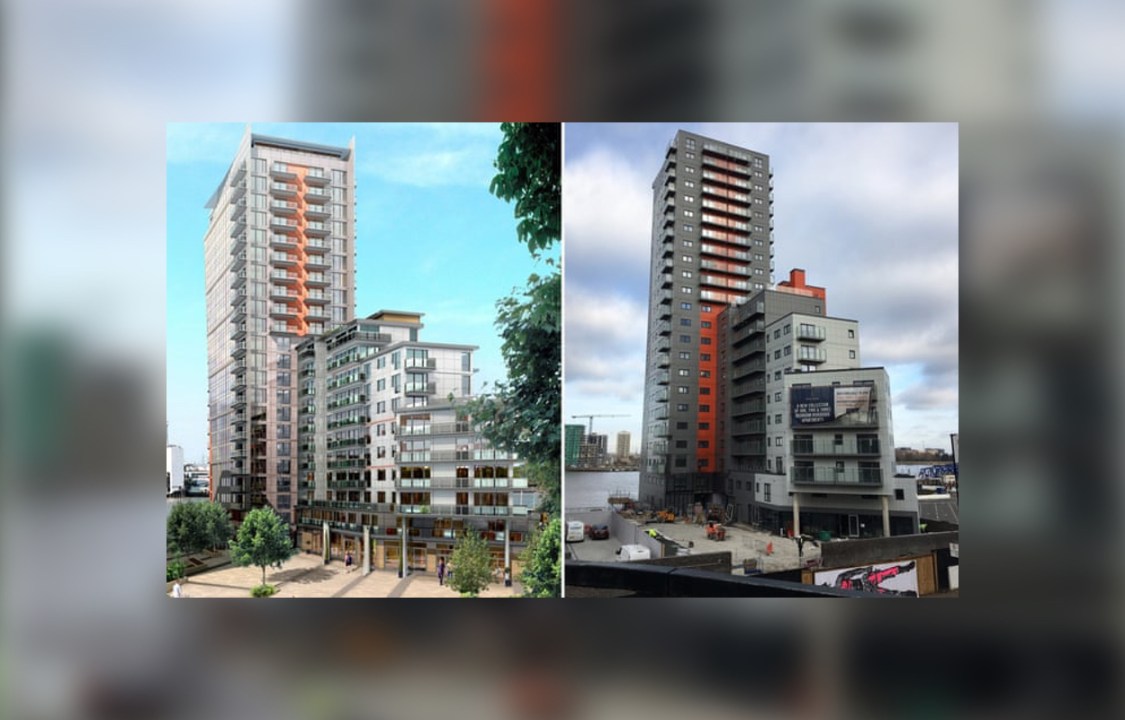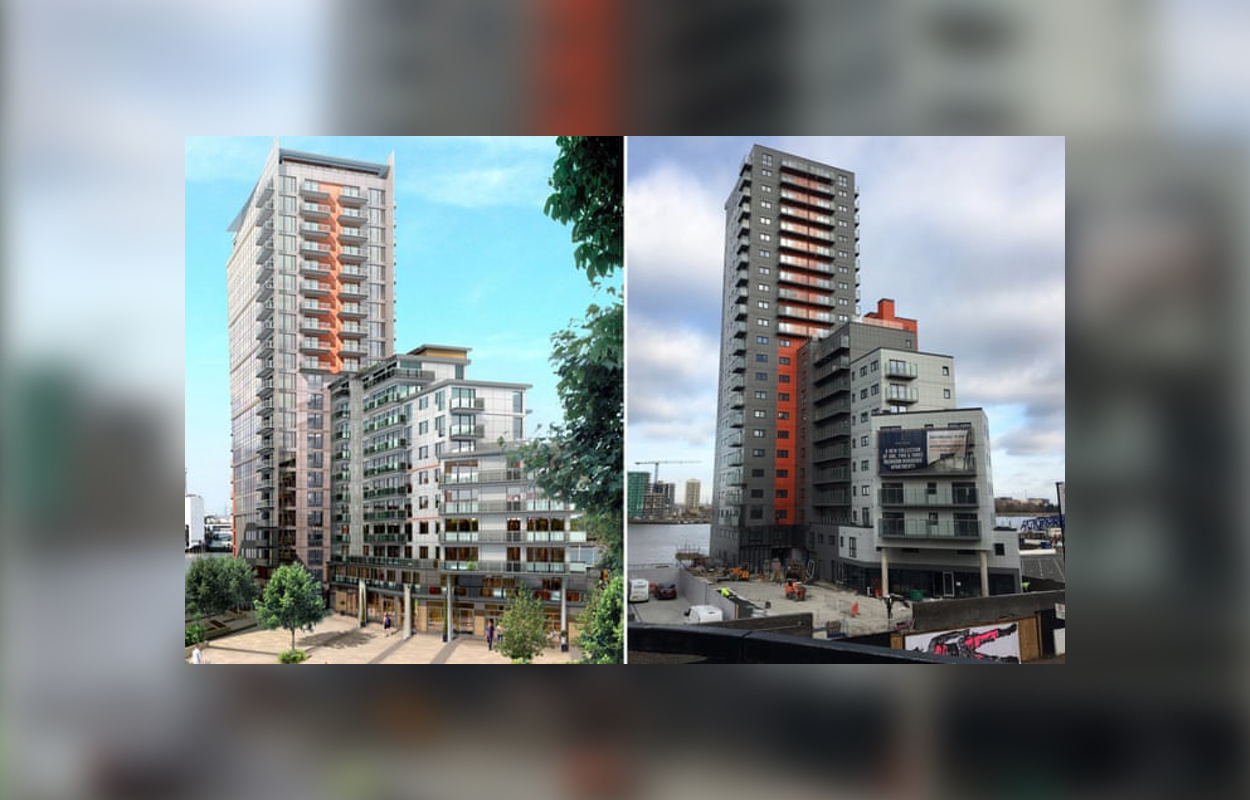It used to be that an ‘artist’s impression’ of a proposed building development was just that; an architectural drawing designed to give planners an idea of what to expect. Then along came CGI and a new era of photorealistic visualisations. On the surface, these glossy new artist’s impressions are anything but impressionistic. Indeed the renderings are so lifelike it’s virtually impossible to tell if they are actual photographs. Ironically, as we are now discovering with AI, hyperrealism is rarely as real as it purports to be.
Current tenants, paying upwards of £1,200 a month for a one-bedroom apartment, are understandably upset about the council’s radical proposal
Last week, it was ordered that the second phase of Mast Quay, a set of tower blocks in Woolwich, southeast London, should be demolished. Greenwich Council put out a comparison picture, one showing the CGI of the proposed development and the other showing what it looks like now it’s been built. There were, officials said, 26 major deviations from the agreed plan for the buildings, which was described by the leader of the council as a pair of ‘mutant’ blocks.
A dearth of building inspectors – six is considered a lot even for larger councils – could partially explain why it has taken until now, after residents had moved in, for anyone to notice the discrepancies with plans approved in 2012. For years hard-pressed councils have been placing way too much trust in what are, in large part, self-policing developers. Making last-minute alterations in the hope that harried inspectors, more used to dealing with rows over kitchen extensions, won’t notice has become an all too regular occurrence. It’s why the owners of the Crooked House pub near Dudley felt they could blithely pull down a quirky, much-loved watering hole without fear of repercussions. Last year, a Royal Town Planning Institute survey of 103 councils found that 80 per cent said they didn’t have enough enforcement officers to cope with a growing backlog.
As for phase two of Mast Quay and the CGI-photo comparisons, it’s hard to tell which is which until you look more closely. The CGI image boasts a suspiciously blue sky and immaculate open spaces. A large blousy tree takes up one side of the image and there are green walkways down to the Thames. As for the actual structures, the CGI version is all shiny New York picture windows glinting in the afternoon sun and wide balconies overlooking the Thames. It’s all very urban chic, until you see the actual image showing a typically leaden English sky and not a trace of greenery in sight. The finished buildings are a shameful Soviet-style hotchpotch of poky windows, suicidal grey and orange cladding and mean little balconies with barely enough room to leap off.
Current tenants, paying upwards of £1,200 a month for a one-bedroom apartment, are understandably upset about the council’s radical proposal. But for those of us sickened by the ceaseless trashing of our once beautiful cityscapes, the decision to punish flagrant flouters can’t come soon enough. It’s a sad reflection of current planning laws that despite perfunctory ‘public consultations’, developers and councils rarely listen to the people whose lives are directly impacted by cynical, badly conceived housing projects.
The fate of Mast Quay phase two reminds me of the public outcry over the late Renzo Piano’s plan to build a tubular skyscraper the height of Canary Warf next to Paddington Station, a couple of blocks from where I live. One of the glossy CGI renderings posted through my letterbox included a view from directly outside my front door with the giant cut-glass rolling pin glowering over the Victorian streets below like some weird alien mothership from the future.
Knowing how these things work, local campaigners immediately sprung into action. Petitions were signed, Simon Jenkins wrote a brilliantly scathing piece in the Evening Standard and a poster was sent to the Westminster planning department declaring ‘Die Shard 2’, a reference to Piano’s other behemoth south of the river.
Remarkably, the council took heed and the Paddington Pole as it had become known was eventually scrapped, only to re-emerge a few months later as something even more shockingly inappropriate. Christened the Ice Cube, presumably because everyone except the council could see right through it, the updated £825 million design passed planning regulations with barely a hitch. It seems campaigners had given Westminster Council too much credit. As usual, aesthetic charm had been low on their list of planning priorities. The main issue with the original Pole had been its excessive height, meaning all the designers needed to do to win approval was squash the mighty erection down into a cube shape. The resulting mess would have a similar square footage as the Pole but with a much larger footprint.
Anyone who has visited Paddington recently will know what a hideous lump of compromise we have ended up with; a bloated jack in the box that manages to dwarf Brunel’s masterwork and overshadow what had once been a shabby but largely unspoilt corner of West London.
From now on, whenever I pass the infernal Cube, which is nearing completion, I will be keeping a close eye out for architectural anomalies. Perhaps one of those original CGI visualisations contains an exaggerated flourish or a decorative appendage not found on the finished structure. Greenwich Council has set an interesting precedent when it comes to the use of wrecking balls.







Comments